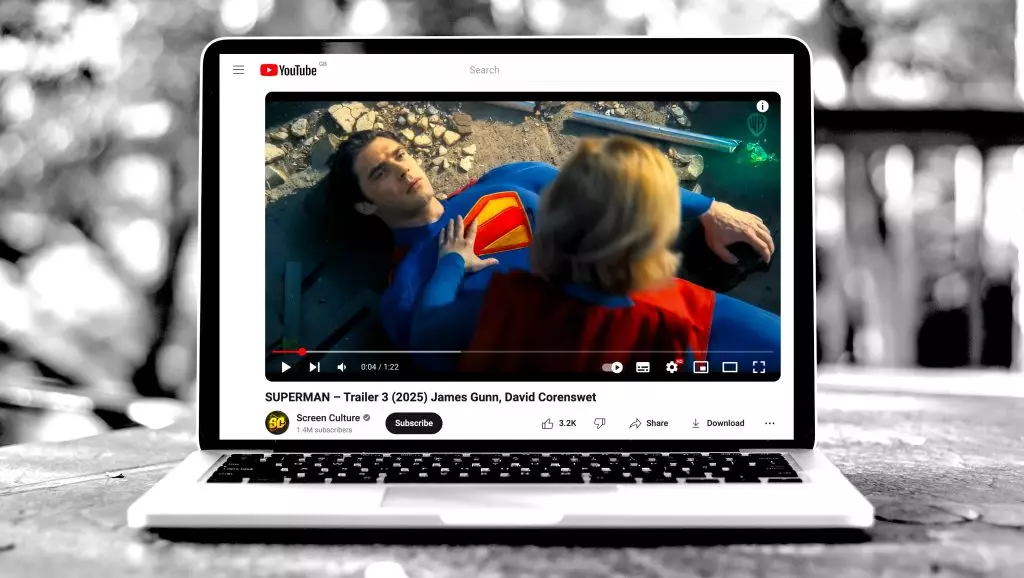In the bustling world of online video content, a remarkable transformation has recently emerged with the advent of artificial intelligence. Channels like Screen Culture and KH Studio have harnessed the power of AI to create highly engaging movie trailers that are visually striking and designed to attract massive viewership. However, this burgeoning trend has also raised significant questions about copyright, originality, and ethical content creation. At its core, this situation highlights a tug-of-war between innovation and the protection of intellectual property, fueled by the unorthodox ways in which these channels reinterpret and amplify established cinematic narratives.
Screen Culture, a noteworthy player in this realm, has captured the essence of popular franchises such as “The Fantastic Four” and “Superman.” By meticulously crafting trailers that replicate the style and tone of official marketing material, they have managed to tap into the resonance of existing fandoms. The integration of AI imagery allows them to tantalize audiences with imaginative spins on beloved characters, creating a compelling allure that elevates viewer engagement to unprecedented levels.
Meanwhile, KH Studio’s forays into bizarre and speculative reimaginings of blockbuster films, such as a hypothetical James Bond adventure featuring Henry Cavill and Margot Robbie, showcase an eccentric creativity that speaks to a yearning for novelty among cinema lovers. By pushing the envelope with exaggerated “what if” scenarios, KH Studio offers viewers an escape from predictability. Yet, in doing so, they teeter on a precarious line that can lead to accusations of misleading audiences.
YouTube’s Tough Love: Battling Monetization Misconduct
In a recent turn of events, YouTube’s decision to suspend monetization features for both Screen Culture and KH Studio emphasizes the platform’s tightening grip on content that flirts with copyright infringement. After an investigative report by Deadline, it became evident that both channels were not just producing content in a creative vacuum; rather, they were manipulating established cinematic properties in ways that attracted scrutiny from major Hollywood studios like Warner Bros. and Sony.
YouTube’s monetization policies are designed to foster a creative ecosystem that maintains integrity and originality. The guidelines explicitly mandate that creators must significantly transform borrowed material to claim it as their own. Channels like Screen Culture and KH Studio, with their focus on borrowed narratives and stylized presentations, have landed in a grey area. Despite the creative intent expressed by individual creators, the risk that arises is the potential for misleading viewers—an aspect that is a red flag for YouTube’s community standards.
The Ethical Dilemma of Creativity vs. Copyright
The recent crackdown raises hard-hitting ethical questions about the nature of creativity in the digital age. How much borrowing is permissible before it becomes infringement? Can AI-generated content be considered original, or does it inevitably tread too closely to the works it aims to emulate? This predicament is exacerbated by the very algorithms that amplify such content, potentially overshadowing official trailers and legitimate sources.
The founders of these channels argue that their intent is to entertain and explore creative possibilities, not to deceive audiences. This sentiment is echoed by KH Studio’s founder, who insists that their work is crafted out of a genuine passion for storytelling rather than a desire for financial gain. Nevertheless, this rationale may not hold water in the face of mounting evidence that suggests audiences can be misled or confused about the authenticity of such trailers.
The dichotomy between these creators’ aspirations and the business realities of the platform underscores a fundamental conflict within the YouTube landscape. Audiences seek fresh and exciting content, while creators strive to push boundaries using new technologies. However, this creative freedom must coexist with a robust framework to protect original works and maintain trust with viewers.
A Future Defined by Innovation and Caution
As technology and creativity continue to evolve together, the ramifications of YouTube’s decision serve as a cautionary tale for content creators everywhere. The balance between originality and respect for intellectual property rights will inevitably shape the future of how creative work is produced and shared online. For channels like Screen Culture and KH Studio, the key will be to navigate this landscape with more caution, ensuring that creativity does not come at the expense of authenticity and fair use.
The developments surrounding these channels encapsulate the larger narrative of an industry grappling with rapid technological advancements while striving to honor the ethos of storytelling. It remains to be seen how this will unfold, but one thing is certain: as audiences embrace innovation, creators must also commit to ethical practices that honor the craft itself.


Leave a Reply